Analysis of Inlet Configurations on the Microclimate Conditions of a Novel Standalone Agricultural Greenhouse for Egypt Using Computational Fluid Dynamics
Abstract
1. Introduction
2. Materials and Methods
2.1. The GH Model
2.2. Building the GH Model with Ansys
3. Results and Discussion
4. Conclusions
Author Contributions
Funding
Institutional Review Board Statement.
Informed Consent Statement.
Data Availability Statement.
Conflicts of Interest
References
- Abdrabbo, M.; Negm, A.; Fath, H.E.; Javadi, A. Greenhouse management and best practice in Egypt. Int. Water Technol. Assoc. 2019, 9, 118–201. [Google Scholar]
- Fath, H.E.-B.S. Desalination and Greenhouses. In Unconventional Water Resources and Agriculture in Egypt; Negm, A.M., Ed.; Springer International Publishing: Cham, Switzerland, 2019; pp. 455–483. [Google Scholar] [CrossRef]
- Hassan, G.E.; Salah, A.H.; Fath, H.; Elhelw, M.; Hassan, A.; Saqr, K.M. Optimum operational performance of a new stand-alone agricultural greenhouse with integrated-TPV solar panels. Sol. Energy 2016, 136, 303–316. [Google Scholar] [CrossRef]
- Maraveas, C. Environmental Sustainability of Greenhouse Covering Materials. Sustainability 2019, 11, 6129. [Google Scholar] [CrossRef]
- Rabbi, B.; Chen, Z.-H.; Sethuvenkatraman, S. Protected Cropping in Warm Climates: A Review of Humidity Control and Cooling Methods. Energies 2019, 12, 2737. [Google Scholar] [CrossRef]
- Abdel-Mawgoud, A.; El-Abd, S.; Singer, S.; Abou-Hadid, A.; Hsiao, T. Effect of shade on the growth and yield of tomato plants. Strateg. Mark. Oriented Greenh. Prod. 1995, 434, 313–320. [Google Scholar] [CrossRef]
- Matsoukis, A.; Kamoutsis, A. Studies on the growth of Lantana camara L. subsp. camara in relation to glasshouse environment and paclobutrazol. Adv. Hortic. Sci. 2003, 17, 153–158. [Google Scholar]
- Gent, M.P. Effect of degree and duration of shade on quality of greenhouse tomato. HortScience 2007, 42, 514–520. [Google Scholar] [CrossRef]
- Aroca-Delgado, R.; Pérez-Alonso, J.; Callejón-Ferre, Á.J.; Velázquez-Martí, B. Compatibility between crops and solar panels: An overview from shading systems. Sustainability 2018, 10, 743. [Google Scholar] [CrossRef]
- Medany, M.; Abdrabbo, M.; Awny, A.; Hassanien, M.; Abou-Hadid, A. Growth and productivity of mango grown under greenhouse conditions. Egypt. J. Hort 2009, 36, 373–382. [Google Scholar]
- Hasanein, N.; Abdrabbo, M.; El-Khulaifi, Y. The effect of bio-fertilizers and amino acids on tomato production and water productivity under net-house conditions. Arab Univ. J. Agric. Sci. 2014, 22, 43–54. [Google Scholar]
- El Afandi, G.; Abdrabbo, M. Evaluation of reference evapotranspiration equations under current climate conditions of Egypt. Turk. J. Agric. Food Sci. Technol. 2015, 3, 819–825. [Google Scholar] [CrossRef]
- Abul-Soud, M.; Emam, M.; Abdrabbo, M. Intercropping of some brassica crops with mango trees under different net house color. Res. J. Agric. Biol. Sci. 2014, 10, 70–79. [Google Scholar]
- Lorenzo, P.; Maroto, C.; Castilla, N. Carbon dioxide air levels in plastic greenhouse in Almeria. Agricultura 1990, 697, 696–698. [Google Scholar]
- Mistriotis, A.; Bot, G.P.A.; Picuno, P.; Scarascia-Mugnozza, G. Analysis of the efficiency of greenhouse ventilation using computational fluid dynamics. Agric. For. Meteorol. 1997, 85, 217–228. [Google Scholar] [CrossRef]
- Papadakis, G.; Mermier, M.; Meneses, J.F.; Boulard, T. Measurement and Analysis of Air Exchange Rates in a Greenhouse with Continuous Roof and Side Openings. J. Agric. Eng. Res. 1996, 63, 219–227. [Google Scholar] [CrossRef]
- Ganguly, A.; Ghosh, S. Model development and experimental validation of a floriculture greenhouse under natural ventilation. Energy Build. 2009, 41, 521–527. [Google Scholar] [CrossRef]
- Kittas, C.; Boulard, T.; Bartzanas, T.; Katsoulas, N.; Mermier, M. Influence of an Insect Screen on Greenhouse Ventilation. Trans. ASAE 2002, 45, 1083. [Google Scholar] [CrossRef]
- Demrati, H.; Boulard, T.; Bekkaoui, A.; Bouirden, L. SE—Structures and Environment: Natural Ventilation and Microclimatic Performance of a Large-scale Banana Greenhouse. J. Agric. Eng. Res. 2001, 80, 261–271. [Google Scholar] [CrossRef]
- Shukla, A.; Tiwari, G.; Sodha, M. Energy conservation potential of inner thermal curtain in an even span greenhouse. Trends Appl. Sci. Res 2006, 1, 542–552. [Google Scholar]
- Rico-Garcia, E.; Lopez-Cruz, I.; Herrera-Ruiz, G.; Soto-Zarazua, G.; Castaneda-Miranda, R. Effect of temperature on greenhouse natural ventilation under hot conditions: Computational Fluid Dynamics simulations. J. Appl. Sci. 2008, 8, 4543–4551. [Google Scholar] [CrossRef]
- Esen, M.; Yuksel, T. Experimental evaluation of using various renewable energy sources for heating a greenhouse. Energy Build. 2013, 65, 340–351. [Google Scholar] [CrossRef]
- Aljubury, I.M.A.; Ridha, H.D.a. Enhancement of evaporative cooling system in a greenhouse using geothermal energy. Renew. Energy 2017, 111, 321–331. [Google Scholar] [CrossRef]
- Von Elsner, B.; Briassoulis, D.; Waaijenberg, D.; Mistriotis, A.; von Zabeltitz, C.; Gratraud, J.; Russo, G.; Suay-Cortes, R. Review of Structural and Functional Characteristics of Greenhouses in European Union Countries: Part I, Design Requirements. J. Agric. Eng. Res. 2000, 75, 1–16. [Google Scholar] [CrossRef]
- Choab, N.; Allouhi, A.; El Maakoul, A.; Kousksou, T.; Saadeddine, S.; Jamil, A. Review on greenhouse microclimate and application: Design parameters, thermal modeling and simulation, climate controlling technologies. Sol. Energy 2019, 191, 109–137. [Google Scholar] [CrossRef]
- Abdel-Ghany, A.M.; Al-Helal, I.M. Solar energy utilization by a greenhouse: General relations. Renew. Energy 2011, 36, 189–196. [Google Scholar] [CrossRef]
- Kittas, C.; Karamanis, M.; Katsoulas, N. Air temperature regime in a forced ventilated greenhouse with rose crop. Energy Build. 2005, 37, 807–812. [Google Scholar] [CrossRef]
- Foster, M.P.; Down, M.J. Ventilation of livestock buildings by natural convection. J. Agric. Eng. Res. 1987, 37, 1–13. [Google Scholar] [CrossRef]
- Lee, S.-Y.; Lee, I.-B.; Kim, R.-W. Evaluation of wind-driven natural ventilation of single-span greenhouses built on reclaimed coastal land. Biosyst. Eng. 2018, 171, 120–142. [Google Scholar] [CrossRef]
- Aich, W.; Kolsi, L.; Borjini, M.N.; Aissia, H.B.; Öztop, H.; Abu-Hamdeh, N. Three-dimensional CFD Analysis of Buoyancy-driven Natural Ventilation and Entropy Generation in a Prismatic Greenhouse. Therm. Sci. 2016, 52, 1–12. [Google Scholar]
- Boulard, T.; Baille, A. Modelling of air exchange rate in a greenhouse equipped with continuous roof vents. J. Agric. Eng. Res. 1995, 61, 37–47. [Google Scholar] [CrossRef]
- Teitel, M.; Ziskind, G.; Liran, O.; Dubovsky, V.; Letan, R. Effect of wind direction on greenhouse ventilation rate, airflow patterns and temperature distributions. Biosyst. Eng. 2008, 101, 351–369. [Google Scholar] [CrossRef]
- Pakari, A.; Ghani, S. Airflow assessment in a naturally ventilated greenhouse equipped with wind towers: Numerical simulation and wind tunnel experiments. Energy Build. 2019, 199, 1–11. [Google Scholar] [CrossRef]
- Majdoubi, H.; Boulard, T.; Fatnassi, H.; Bouirden, L. Airflow and microclimate patterns in a one-hectare Canary type greenhouse: An experimental and CFD assisted study. Agric. For. Meteorol. 2009, 149, 1050–1062. [Google Scholar] [CrossRef]
- Bournet, P.-E.; Boulard, T. Effect of ventilator configuration on the distributed climate of greenhouses: A review of experimental and CFD studies. Comput. Electron. Agric. 2010, 74, 195–217. [Google Scholar] [CrossRef]
- Campen, J.; Bot, G. Determination of greenhouse-specific aspects of ventilation using three-dimensional computational fluid dynamics. Biosyst. Eng. 2003, 84, 69–77. [Google Scholar] [CrossRef]
- Shklyar, A.; Arbel, A. Numerical model of the three-dimensional isothermal flow patterns and mass fluxes in a pitched-roof greenhouse. J. Wind Eng. Ind. Aerodyn. 2004, 92, 1039–1059. [Google Scholar] [CrossRef]
- Kittas, C.; Katsoulas, N.; Bartzanas, T.; Mermier, M.; Boulard, T. The impact of insect screens and ventilation openings on the greenhouse microclimate. Trans. ASABE 2008, 51, 2151–2165. [Google Scholar] [CrossRef]
- Molina-Aiz, F.D.; Fatnassi, H.; Boulard, T.; Roy, J.C.; Valera, D.L. Comparison of finite element and finite volume methods for simulation of natural ventilation in greenhouses. Comput. Electron. Agric. 2010, 72, 69–86. [Google Scholar] [CrossRef]
- Ayuga, F. Present and future of the numerical methods in buildings and infrastructures areas of biosystems engineering. J. Agric. Eng. 2015, 46, 1–12. [Google Scholar] [CrossRef]
- Teitel, M.; Liran, O.; Tanny, J.; Barak, M. Wind driven ventilation of a mono-span greenhouse with a rose crop and continuous screened side vents and its effect on flow patterns and microclimate. Biosyst. Eng. 2008, 101, 111–122. [Google Scholar] [CrossRef]
- Teitel, M.; Wenger, E. Air exchange and ventilation efficiencies of a monospan greenhouse with one inflow and one outflow through longitudinal side openings. Biosyst. Eng. 2014, 119, 98–107. [Google Scholar] [CrossRef]
- Lee, I.-B.; Bitog, J.P.P.; Hong, S.-W.; Seo, I.-H.; Kwon, K.-S.; Bartzanas, T.; Kacira, M. The past, present and future of CFD for agro-environmental applications. Comput. Electron. Agric. 2013, 93, 168–183. [Google Scholar] [CrossRef]
- Tong, G.; Christopher, D.M.; Zhang, G. New insights on span selection for Chinese solar greenhouses using CFD analyses. Comput. Electron. Agric. 2018, 149, 3–15. [Google Scholar] [CrossRef]
- Benni, S.; Tassinari, P.; Bonora, F.; Barbaresi, A.; Torreggiani, D. Efficacy of greenhouse natural ventilation: Environmental monitoring and CFD simulations of a study case. Energy Build. 2016, 125, 276–286. [Google Scholar] [CrossRef]
- Afou, Y.E.; Msaad, A.A.; Kousksou, T.; Mahdaoui, M. Predictive control of temperature under greenhouse using LQG strategy. In Proceedings of the 2015 3rd International Renewable and Sustainable Energy Conference (IRSEC), Ouarzazate, Morocco, 10–13 December 2015; pp. 1–5. [Google Scholar]
- Bot, G.P. Physical modeling of greenhouse climate. IFAC Proc. Vol. 1991, 24, 7–12. [Google Scholar] [CrossRef]
- Su, Y.; Xu, L. Towards discrete time model for greenhouse climate control. Eng. Agric. Environ. Food 2017, 10, 157–170. [Google Scholar] [CrossRef]
- Iga, J.L.; García, E.A.; Fuentes, H.R. Modeling and Validation of a Greenhouse Climate Model. IFAC Proc. Vol. 2005, 38, 173–178. [Google Scholar] [CrossRef]
- Paull, R. Effect of temperature and relative humidity on fresh commodity quality. Postharvest Biol. Technol. 1999, 15, 263–277. [Google Scholar] [CrossRef]
- Sharkey, T.D.; Loreto, F. Water stress, temperature, and light effects on the capacity for isoprene emission and photosynthesis of kudzu leaves. Oecologia 1993, 95, 328–333. [Google Scholar] [CrossRef]
- Kittas, C.; Katsoulas, N.; Bartzanas, T. Greenhouse climate control in mediterranean greenhouses. Cuad. Estud. Agroaliment. 2012, 3, 89–114. [Google Scholar]
- Yohannes, T.; Fath, H. Novel agriculture greenhouse that grows its water and power: Thermal analysis. In Proceedings of the 24th Canadian Congress of Applied Mechanics CANCAM, Saskatoon, SK, Canada, 2–6 June 2013. [Google Scholar]
- Akrami, M.; Salah, A.H.; Javadi, A.A.; Fath, H.E.S.; Hassanein, M.J.; Farmani, R.; Dibaj, M.; Negm, A. Towards a Sustainable Greenhouse: Review of Trends and Emerging Practices in Analysing Greenhouse Ventilation Requirements to Sustain Maximum Agricultural Yield. Sustainability 2020, 12, 2794. [Google Scholar] [CrossRef]
- Salah, A.H.; Hassan, G.E.; Fath, H.; Elhelw, M.; Elsherbiny, S. Analytical investigation of different operational scenarios of a novel greenhouse combined with solar stills. Appl. Therm. Eng. 2017, 122, 297–310. [Google Scholar] [CrossRef]
- Amarananwatana, P.; Sorapipatana, C. An assessment of the ASHRAE clear sky model for irradiance prediction in Thailand Nuntiya. Asian J. Energy Env. 2007, 8, 523–532. [Google Scholar]
- ASHRAE Handbook—Fundamentals; American Society of Heating, Refrigerating and Air-Conditioning Engineers, Inc.: Atlanta, GA, USA, 2009.
- Wu, W.-Y.; Lan, C.-W.; Lo, M.-H.; Reager, J.T.; Famiglietti, J.S. Increases in the annual range of soil water storage at northern middle and high latitudes under global warming. Geophys. Res. Lett. 2015, 42, 3903–3910. [Google Scholar] [CrossRef]
- Akrami, M.; Salah, A.H.; Dibaj, M.; Porcheron, M.; Javadi, A.A.; Farmani, R.; Fath, H.E.S.; Negm, A. A Zero-Liquid Discharge Model for a Transient Solar-Powered Desalination System for Greenhouse. Water 2020, 12, 1440. [Google Scholar] [CrossRef]
- Salah, A.; Fath, H.; Negm, A.; Akrami, M.; Javadi, A. Simulation of agriculture greenhouse integrated with on-roof Photo-Voltaic panels: Case study for a winter day. In Proceedings of the International Conference on Innovative Applied Energy (IAPE’20), Cambridge, UK, 15–16 September 2020. [Google Scholar]
- Mistriotis, A.; Arcidiacono, C.; Picuno, P.; Bot, G.P.A.; Scarascia-Mugnozza, G. Computational analysis of ventilation in greenhouses at zero- and low-wind-speeds. Agric. For. Meteorol. 1997, 88, 121–135. [Google Scholar] [CrossRef]
- Okushima, L.; Sase, S.; Nara, M. A support system for natural ventilation design of greenhouses based on computational aerodynamics. In Proceedings of the International Symposium on Models for Plant Growth, Environmental Control and Farm Management in Protected Cultivation 248, Hanover Germany, 28 August–2 September 1988; pp. 129–136. [Google Scholar]
- Sase, S.; Takakura, T.; Nara, M. Wind tunnel testing on airflow and temperature distribution of a naturally ventilated greenhouse. In Proceedings of the III International Symposium on Energy in Protected Cultivation 148, Columbus, OH, USA, 21–26 August 1983; pp. 329–336. [Google Scholar]
- Akrami, M.; Javadi, A.A.; Hassanein, M.J.; Farmani, R.; Dibaj, M.; Tabor, G.R.; Negm, A. Study of the Effects of Vent Configuration on Mono-Span Greenhouse Ventilation Using Computational Fluid Dynamics. Sustainability 2020, 12, 986. [Google Scholar] [CrossRef]
- Hu, J.; Cai, W.; Li, C.; Gan, Y.; Chen, L. In situ X-ray diffraction study of the thermal expansion of silver nanoparticles in ambient air and vacuum. Appl. Phys. Lett. 2005, 86, 151915. [Google Scholar] [CrossRef]
- Tang, J.C.; Lin, G.L.; Yang, H.C.; Jiang, G.J.; Chen-Yang, Y.W. Polyimide-silica nanocomposites exhibiting low thermal expansion coefficient and water absorption from surface-modified silica. J. Appl. Polym. Sci. 2007, 104, 4096–4105. [Google Scholar] [CrossRef]
- Fernández, M.; Bonachela, S.; Orgaz, F.; Thompson, R.; López, J.; Granados, M.; Gallardo, M.; Fereres, E. Measurement and estimation of plastic greenhouse reference evapotranspiration in a Mediterranean climate. Irrig. Sci. 2010, 28, 497–509. [Google Scholar] [CrossRef]
- Bartzanas, T.; Boulard, T.; Kittas, C. Effect of Vent Arrangement on Windward Ventilation of a Tunnel Greenhouse. Biosyst. Eng. 2004, 88, 479–490. [Google Scholar] [CrossRef]


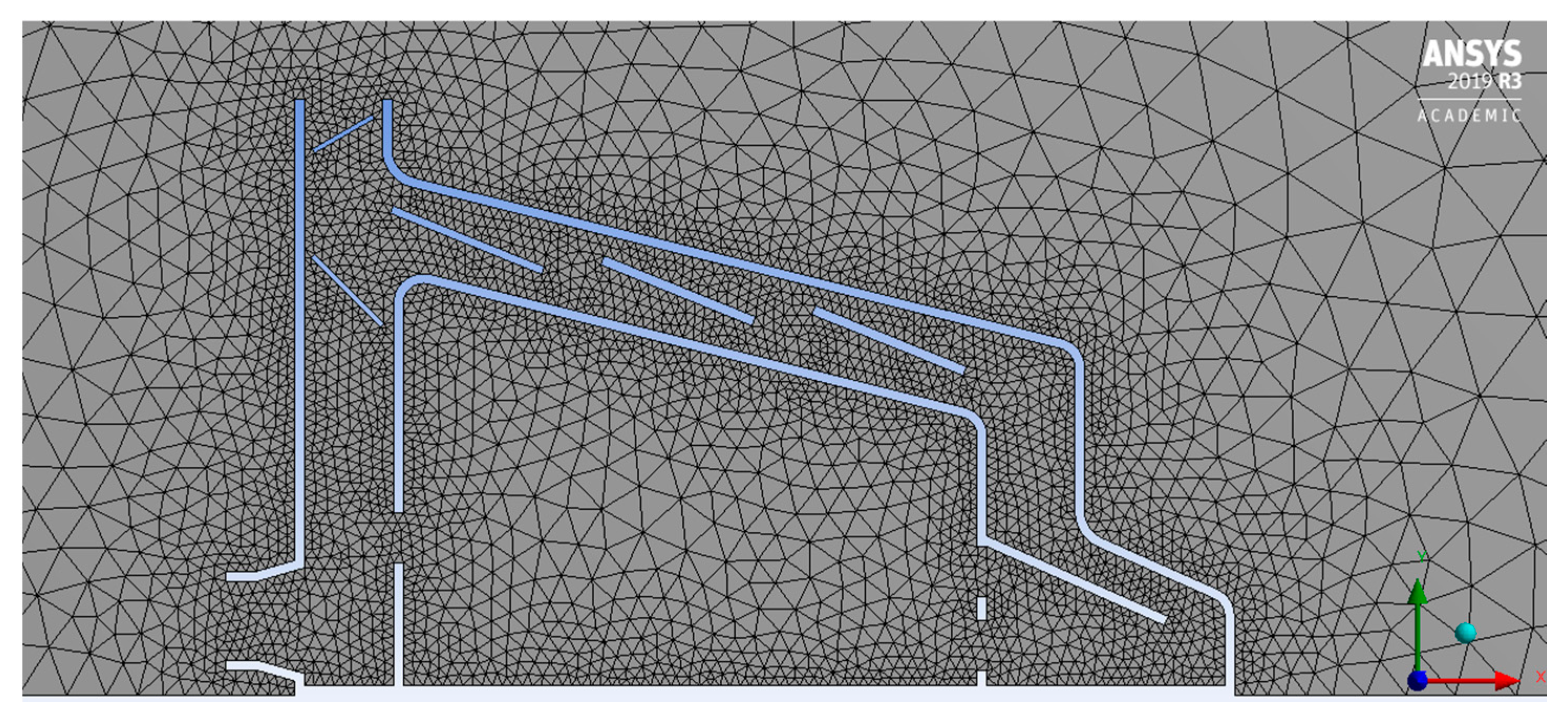
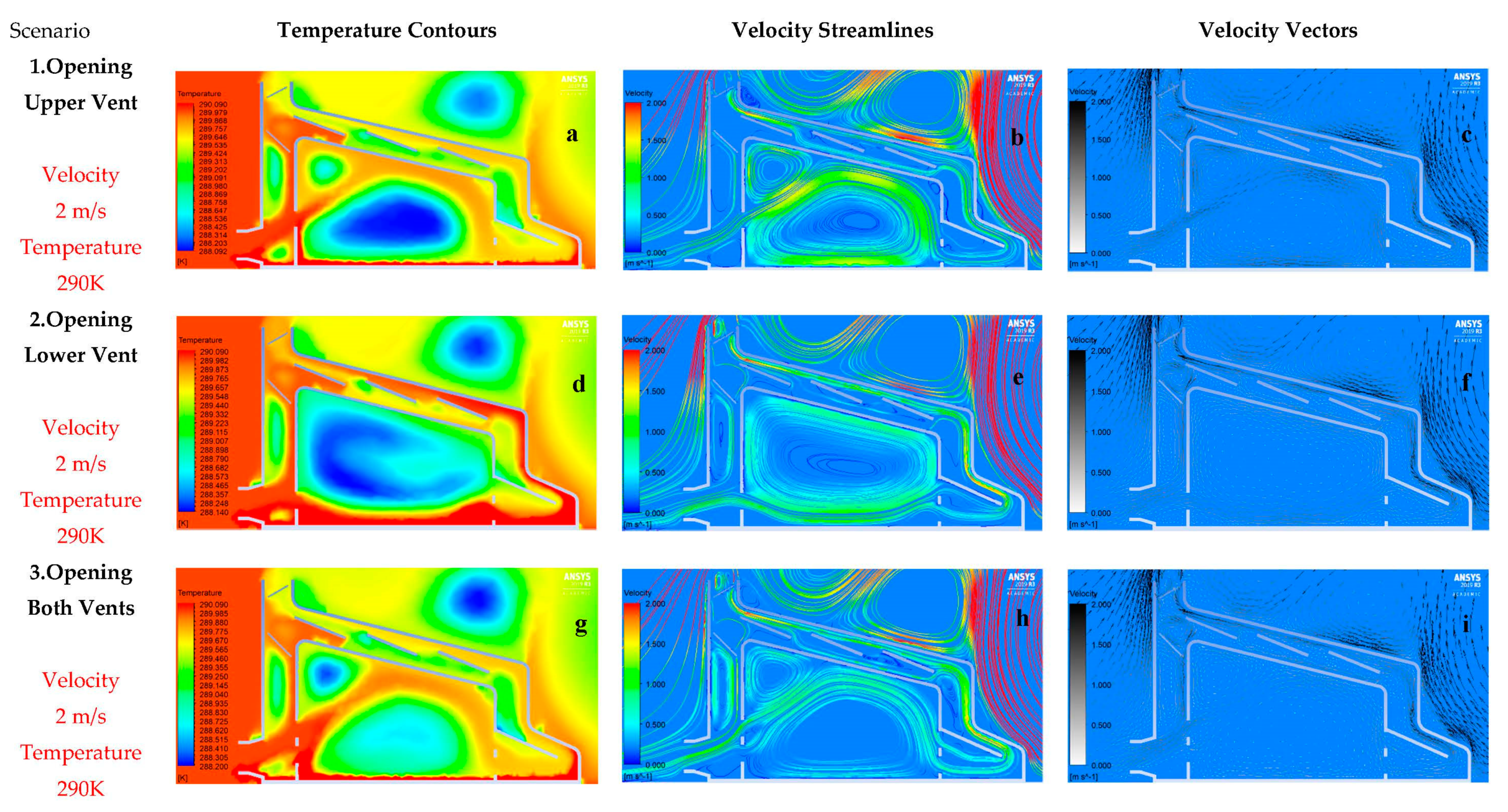
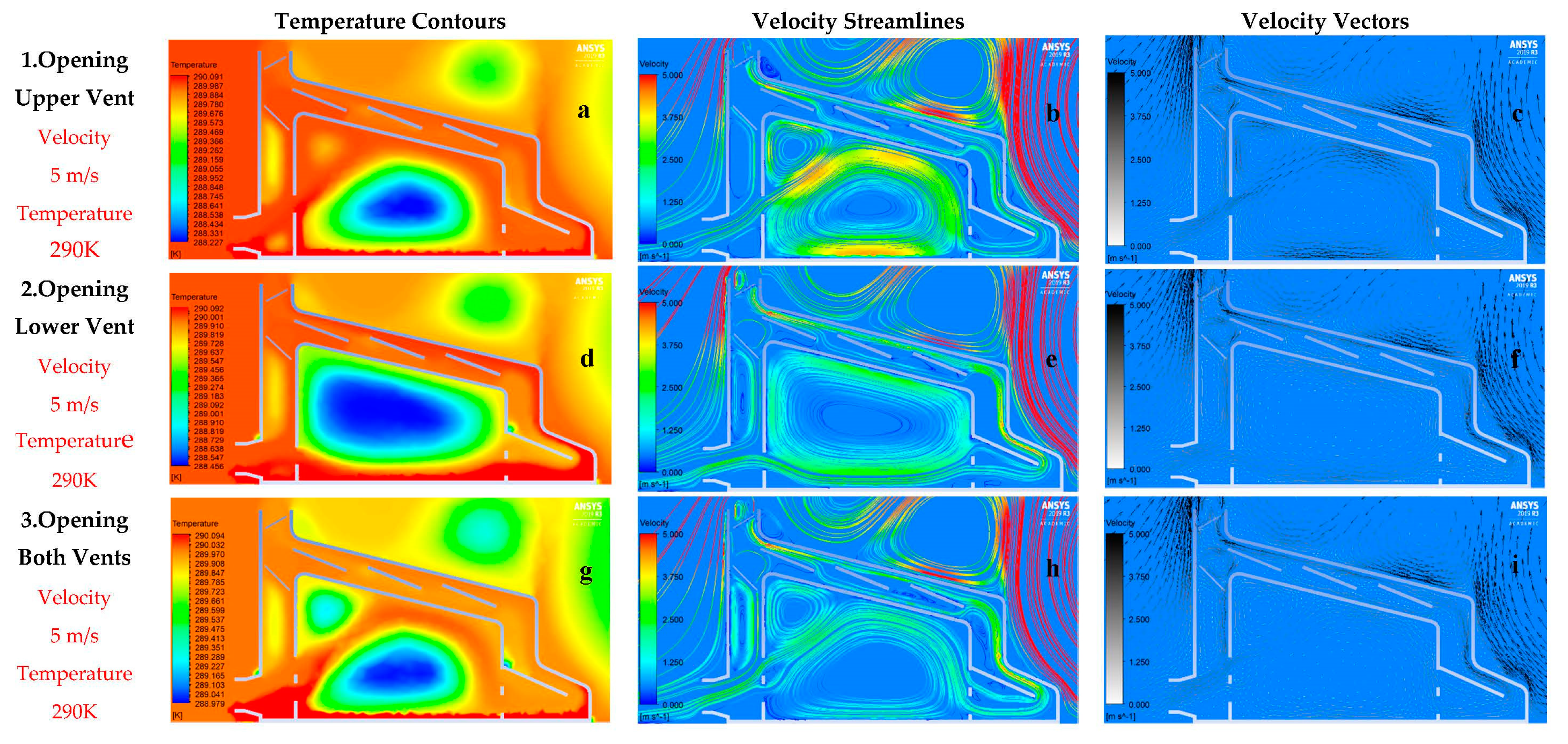
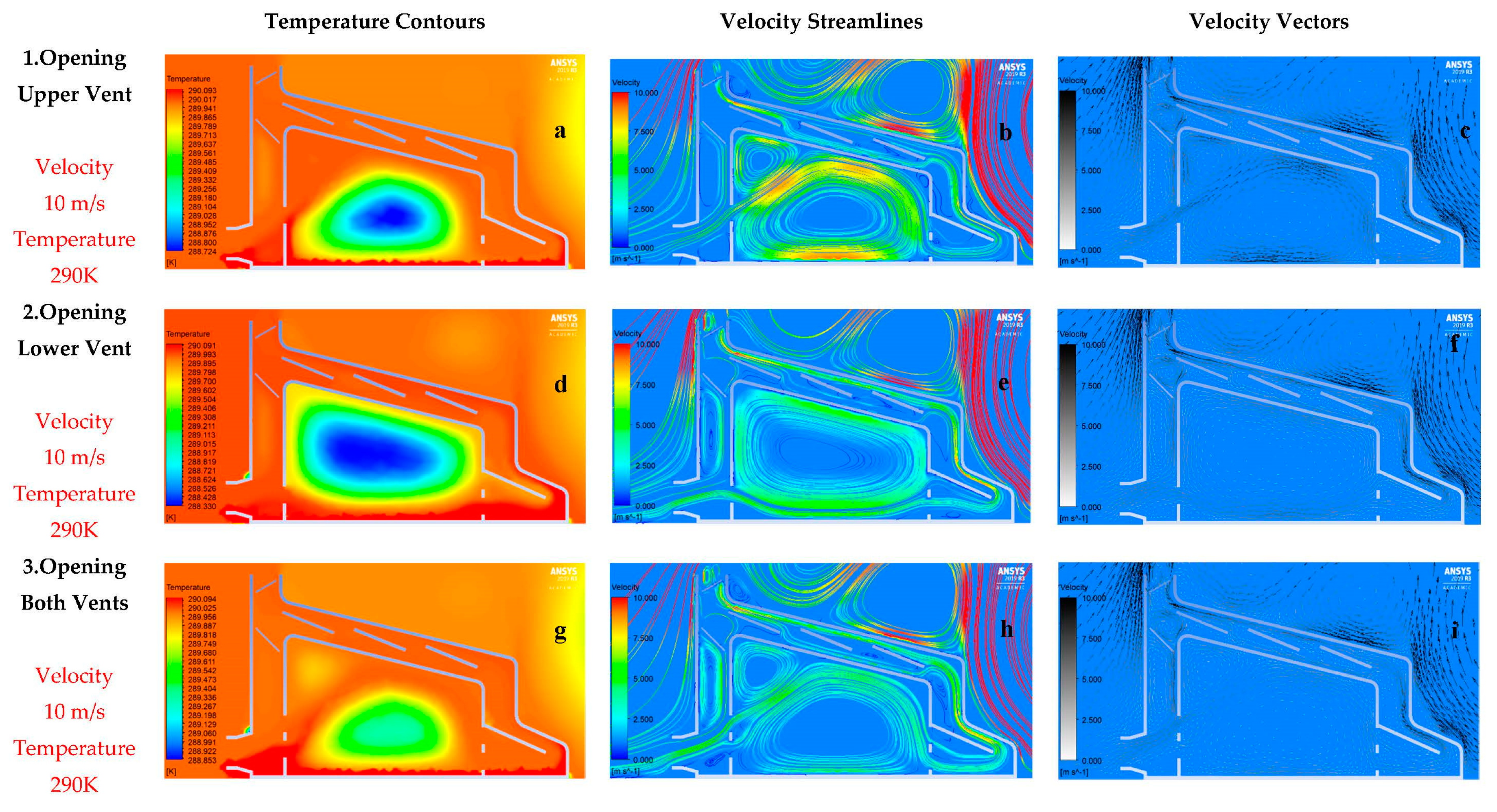

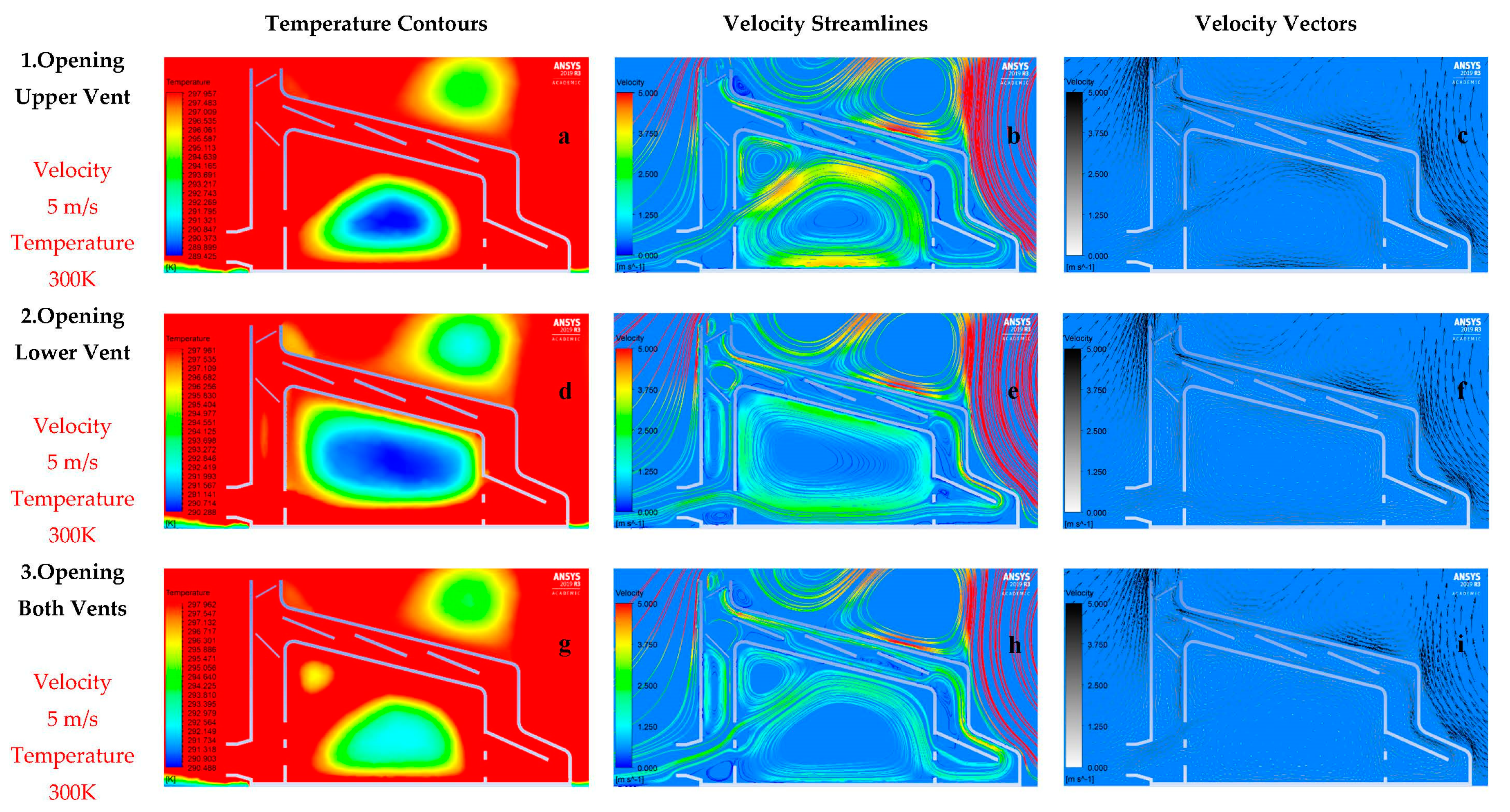
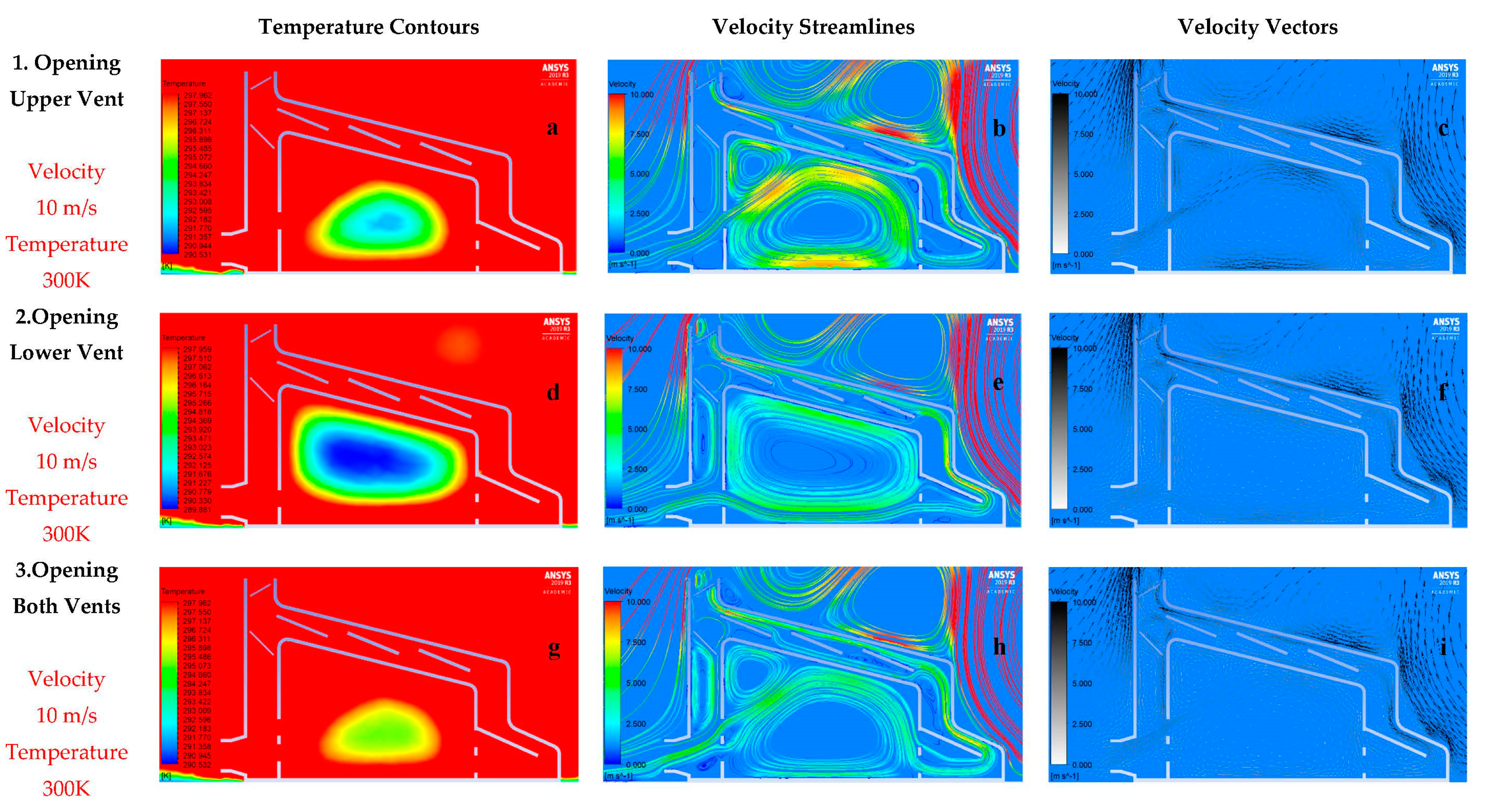

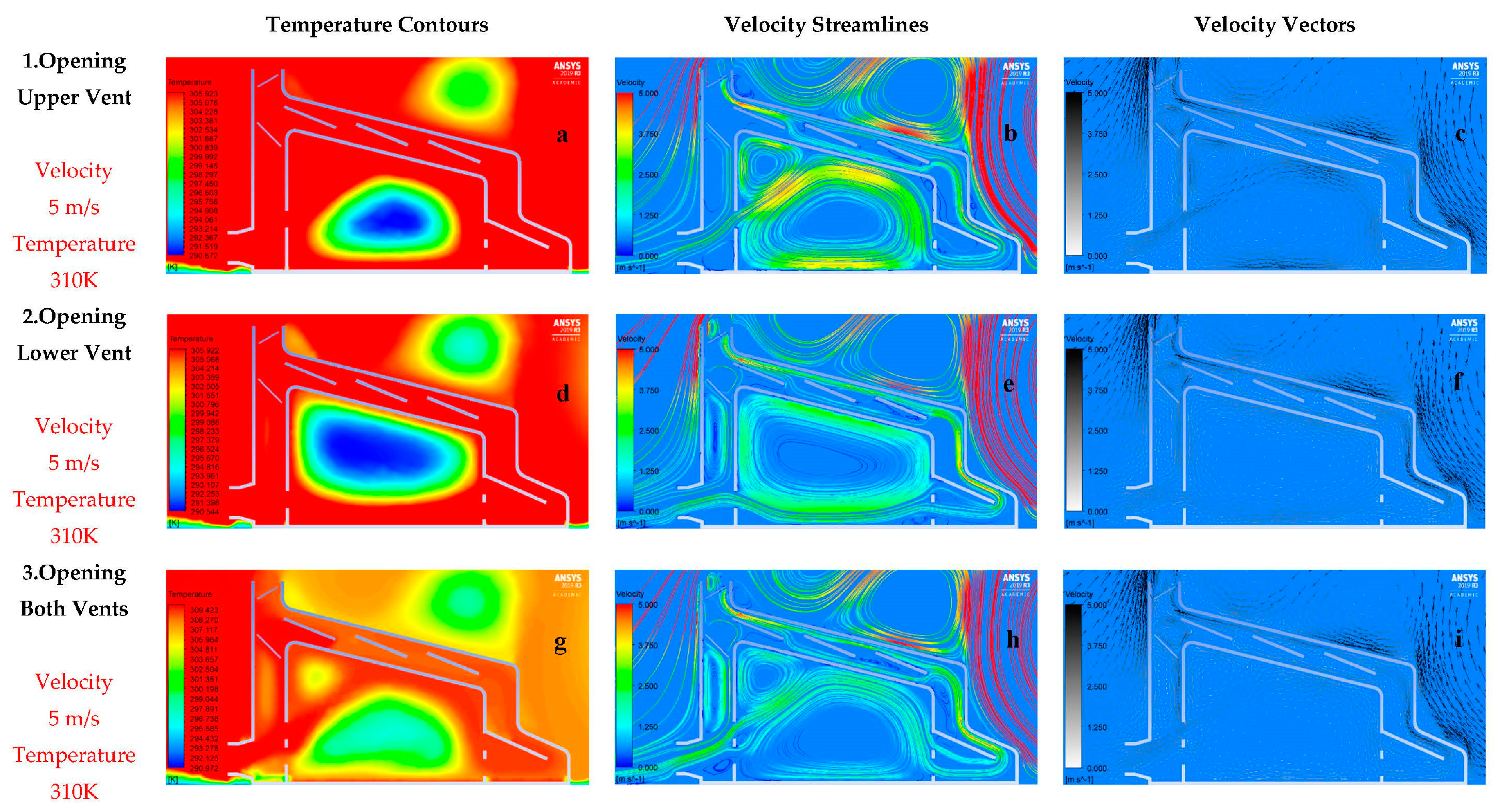
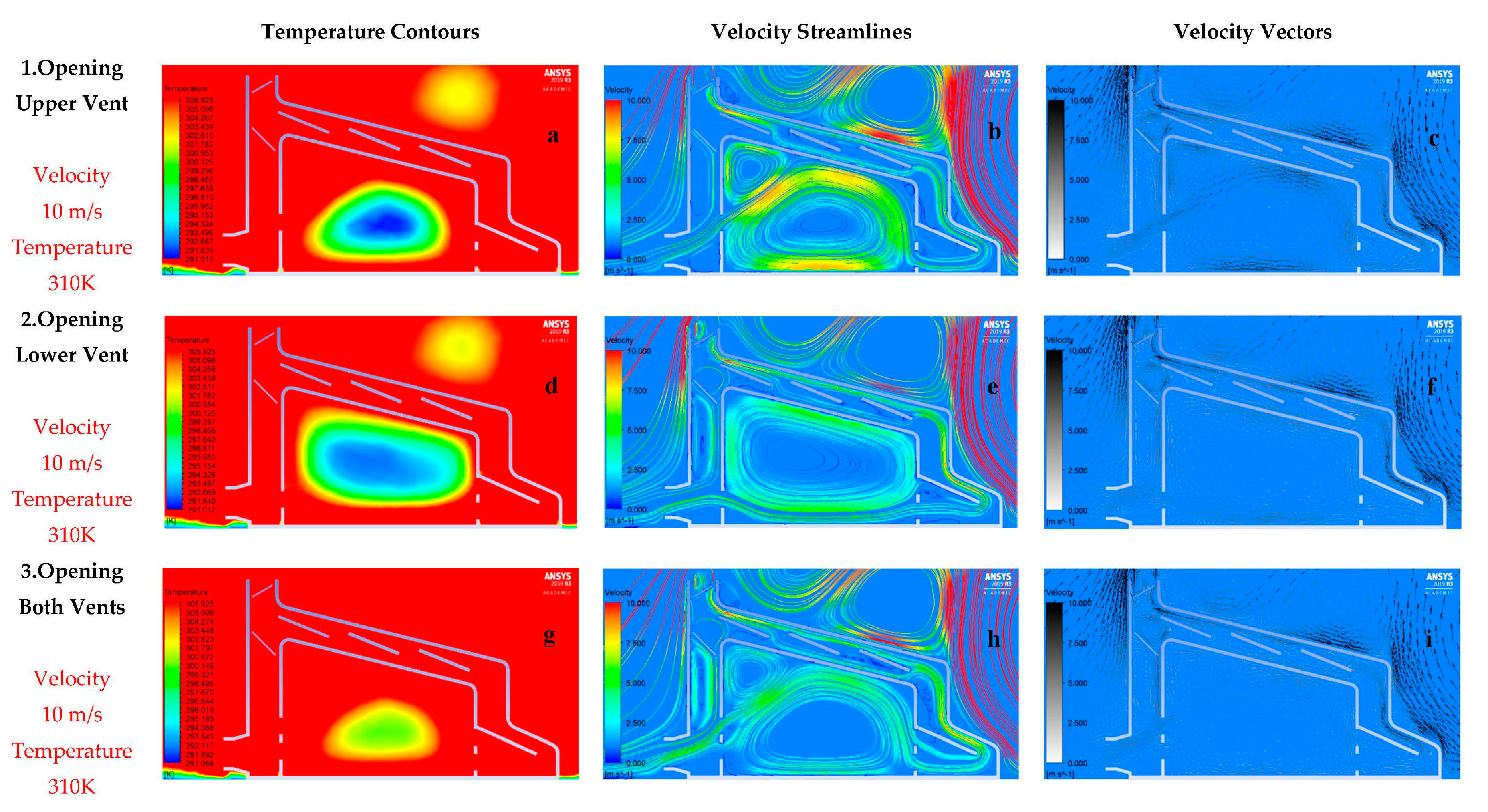
| Name of Dimensions | Value |
|---|---|
| Height of the main inlet | 1.00 m |
| Height of the left-side external wall from top point to ground | 5.80 m |
| Width of the main outlet | 0.90 m |
| Length of the external roof | 7.21m |
| Height of the right-side external wall from the roof to ground | 2.88 m |
| Length of the greenhouse | 8.25 m |
| Width of the internal vent | 0.50 m |
| Height of the left-side internal wall | 4.26 m |
| Length of the internal roof | 5.56 m |
| Height of the right-side internal wall from no. 9 to ground | 2.50 m |
| Width of the rear vents | 0.50 m |
| Length of the rear blade | 2.00 m |
| Length of the solar stills | 1.60 m |
| Length of the baffles | 1.00 m |
| Material | Density (kg m−3) | Specific Heat (J kg−1 K−1) | Thermal Conductivity (W m−1 K−1) |
|---|---|---|---|
| Glass | 2400 | 753 | 1.0 |
| Soil | 2200 | 871 | 0.5 |
| Named Selection | Boundary Type | Boundary Condition(s) |
|---|---|---|
| GH Walls | Wall (glass) | T = 310 K |
| GH Roof | Wall (glass) | T = 310 K |
| GH Floor | Wall (soil) | T = 320 K |
| External Floor | Wall (soil) | T = 300 K |
| Inlet | Velocity inlet | U = 2 ms−1, 5 ms−1, 10 ms−1 T = 290 K, 300 K, 310 K |
| Outlet | Pressure outlet | N/A |
| Internal Roof | Symmetry | N/A |
Publisher’s Note: MDPI stays neutral with regard to jurisdictional claims in published maps and institutional affiliations. |
© 2021 by the authors. Licensee MDPI, Basel, Switzerland. This article is an open access article distributed under the terms and conditions of the Creative Commons Attribution (CC BY) license (http://creativecommons.org/licenses/by/4.0/).
Share and Cite
Akrami, M.; Mutlum, C.D.; Javadi, A.A.; Salah, A.H.; Fath, H.E.S.; Dibaj, M.; Farmani, R.; Mohammed, R.H.; Negm, A. Analysis of Inlet Configurations on the Microclimate Conditions of a Novel Standalone Agricultural Greenhouse for Egypt Using Computational Fluid Dynamics. Sustainability 2021, 13, 1446. https://doi.org/10.3390/su13031446
Akrami M, Mutlum CD, Javadi AA, Salah AH, Fath HES, Dibaj M, Farmani R, Mohammed RH, Negm A. Analysis of Inlet Configurations on the Microclimate Conditions of a Novel Standalone Agricultural Greenhouse for Egypt Using Computational Fluid Dynamics. Sustainability. 2021; 13(3):1446. https://doi.org/10.3390/su13031446
Chicago/Turabian StyleAkrami, Mohammad, Can Dogan Mutlum, Akbar A. Javadi, Alaa H. Salah, Hassan E. S. Fath, Mahdieh Dibaj, Raziyeh Farmani, Ramy H. Mohammed, and Abdelazim Negm. 2021. "Analysis of Inlet Configurations on the Microclimate Conditions of a Novel Standalone Agricultural Greenhouse for Egypt Using Computational Fluid Dynamics" Sustainability 13, no. 3: 1446. https://doi.org/10.3390/su13031446
APA StyleAkrami, M., Mutlum, C. D., Javadi, A. A., Salah, A. H., Fath, H. E. S., Dibaj, M., Farmani, R., Mohammed, R. H., & Negm, A. (2021). Analysis of Inlet Configurations on the Microclimate Conditions of a Novel Standalone Agricultural Greenhouse for Egypt Using Computational Fluid Dynamics. Sustainability, 13(3), 1446. https://doi.org/10.3390/su13031446










